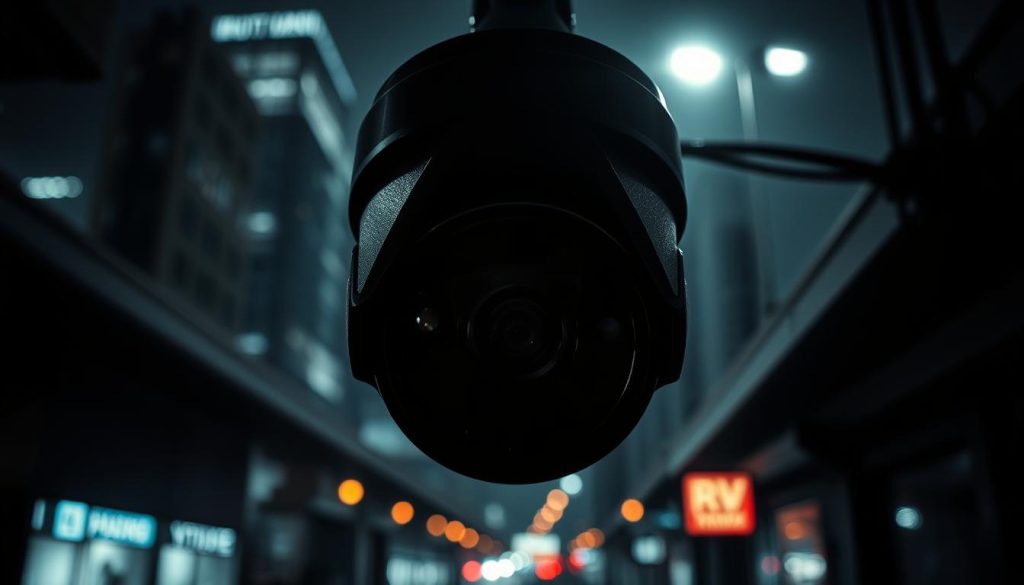Security cameras are key in keeping homes and businesses safe, even in busy places like Singapore. But, they can stop working due to many reasons. Problems like electrical issues, connection problems, and hardware failures can really mess up their performance.
Knowing what causes these problems helps property owners take better care of their cameras. This way, they can keep their places safe and secure.
Key Takeaways
- Security cameras are vital for watching over properties.
- Video loss can be caused by various issues.
- Electrical and connectivity challenges are common culprits.
- Understanding camera failure helps in maintenance.
- Proper upkeep ensures reliable surveillance systems.
Understanding Video Loss in Security Cameras
Video loss in security cameras is a big problem. It can make CCTV systems less effective. This issue can cause a complete blackout, flickering images, or no video feed at all. It can happen to one camera or many, so it’s important to find out why.
Some common reasons for video loss include not enough power, bad cables, and network issues. Knowing these problems helps users fix them. This keeps their surveillance systems working well.
Common Forms of Video Loss
Video loss in security cameras can show up in several annoying ways. It’s key to spot these signs to keep your system working right. Here are two common types that users might see, each pointing to issues that need fixing fast.
Black screens and no video feeds
Seeing black screens or no video feeds is scary. It could mean big problems, like power issues or bad connections. Check the wiring and power sources to make sure everything is hooked up right.
Flickering video and lines on screen
Flickering video or lines on the screen suggest trouble. This could be from interference or broken parts in the camera or its devices. Fixing these problems fast can stop bigger failures of your security setup.
What Causes Video Loss in Security Cameras?
Video loss in security cameras can happen for many reasons. One big cause is not enough power. This can be due to loose connections, bad power adapters, or old equipment. Also, unstable networks can cause security camera failure by messing up data transmission.
Another reason is cable problems. Damaged or wrong wiring can block a clear video. Plus, faulty hardware parts can fail without easy fixes. Finding these problems is key to fixing cameras.
Insufficient Power Supply Issues
One big problem with security cameras is not enough power. This can happen for many reasons, like cable connections and power adapters. It’s key to keep the power steady for security systems to work right.
Loose cable connections
When cables between the DVR/NVR and cameras are loose, power can stop flowing. This can cause cameras to work poorly or not at all. It’s important to check and fix these cable connections often. Look for any damage or wear that might affect power.
Power adapters and their effects
The right power adapters are important for security cameras. The wrong ones can cause power problems. If many cameras use the same power, each gets less power.
Using a special power adapter for each camera helps a lot. Checking these adapters often can help find and fix any issues. This keeps your cameras working well.
Power Spikes and Interference Effects
Security cameras can face big problems from power spikes and electrical interference. These issues can cause short-term or long-term damage to the cameras.
Impact of lightning strikes
Lightning strikes are a big danger for security cameras. The surge from a lightning strike can harm the camera’s inside parts. This is more likely if the camera is on a metal surface.
Problems from electrical currents
Electrical interference from other devices can mess with security cameras. It might make the cameras act strangely or stop working. To fix this, using surge protectors is key. They soak up extra voltage from power spikes, keeping the cameras safe and working well.
Network Connectivity Problems
Network issues are key to how well security cameras work. Bad Wi-Fi connectivity often causes video loss. It’s important to find out why these problems happen.
Being too far from the router can hurt the camera’s connection. Walls or other things can also get in the way.
It’s a good idea to check your network setup often. Moving cameras closer to routers can help. Using Wi-Fi extenders is also a good idea. A strong signal is key for good video surveillance.
Why do security cameras go bad?
Security cameras can fail for many reasons, causing problems with surveillance. Age, environmental damage, and misuse are common causes. As time goes by, parts can wear out, affecting how well they work.
Old firmware can also cause issues with device compatibility. This makes security cameras less reliable. Regular troubleshooting and upkeep are key to avoiding these problems. It’s important to check your systems often for any signs of trouble.
Being proactive helps prevent camera failures. For more tips on keeping your security systems in top shape, check out how updates and inspections can help.
Knowing why cameras fail helps you protect your space better. It ensures your surveillance systems work as they should.
IR Cut Filters and Night Vision Failures
Night vision cameras are key for watching areas at night. They work well because of IR cut filters. These filters block infrared light in the day and let infrared sensors capture clear images at night. If these filters fail, users might see black screens, making it hard to see what’s happening.
Many things can cause IR cut filters and sensors to fail. A bad sensor can make it hard to see in the dark. Also, wrong camera settings can mess up the day and night switch. It’s important to check how well cameras work in low light to keep nighttime surveillance reliable.

Role of Signal Types and Compatibility
When setting up surveillance, knowing about signal types and camera compatibility is key. Users often face problems, like connecting old cameras to new systems. This is because new systems use different signal formats.
Older cameras and new DVR compatibility
Old cameras might not send the signals that new systems need. It’s important to check if old cameras work with new systems. Looking at factory specs before buying can help avoid problems.
Understanding compatibility issues
Issues like video loss or cameras not working can happen. Not all gear works well together. Using the same brand and keeping firmware up to date helps. Knowing about signal types helps avoid problems during setup.
Wiring Faults and Cable Issues
Wiring problems can really mess up how well security cameras work. They often cause video loss. This happens because damaged or frayed cables can’t send signals properly.
It’s important to keep an eye on all the cables in your system. This helps make sure your surveillance is always up and running.
Keeping cables in good shape is key. Check that all connections are tight and that cables look okay. If you see any damage, swap them out for new, high-quality ones.
This way, you can avoid video loss and make your security system more reliable.
Hardware and Firmware Problems
Keeping security cameras working well is key. You need to watch out for both hardware and firmware issues. This ensures they work their best and keep you safe.
Many people forget about firmware problems. These can really mess up how your cameras work. Outdated firmware can cause bugs and make systems unreliable. So, updating firmware is very important.
Importance of firmware updates
Firmware updates are critical for security camera maintenance. They add new features and fix bugs that can cause problems. By keeping firmware up to date, you can avoid downtime.
It’s also important to check the hardware regularly. Look for any physical damage or wear. This can help prevent bigger problems later on.
IP Address Conflicts and Their Consequences
IP address conflicts can really mess up your security cameras. When many devices try to use the same IP address, it causes big problems. These issues might stop cameras from connecting to the network or make them drop connections.
This is a big deal because it affects how well you can watch and monitor your surroundings. To fix this, it’s important to check the IP settings of your cameras and other devices on your network. Make sure each camera has its own unique IP address.
Doing this regularly helps keep your cameras working smoothly. It’s even more important in places with lots of devices connected. By staying on top of this, you can make your surveillance system more reliable and keep your place safer.

